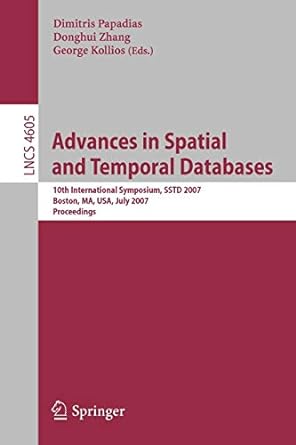Answered step by step
Verified Expert Solution
Question
1 Approved Answer
Implement an AVL tree ADT. The design of the class is up to you. You may choose to use as much or as little of
Implement an AVL tree ADT. The design of the class is up to you. You may choose to use as much
or as little of libasn as you desire including extending existing classes, implementing existing
interfaces, taking pieces of code for your own methods, or not using any of libasn at all but you
will be graded on the appropriateness of your choices, so make good choices. Employ good software
engineering principles in making your decisions.
Regardless of your design decisions, you can earn full marks for correctness of implementation as
long as the following requirements are met:
Your AVL tree ADT must be able to contain elements of any comparable object type, but all
elements in a single tree are the same type.
Your ADT must support insertion of new elements, one at a time. Additionally, the insertion
algorithm implementation must have the following properties:
It must be Olog n in the worst case. This means you have to store subtree heights in the
nodes see previous section to avoid incurring the lineartime cost of a recursive height
method. Part marks will be given for solutions that are at worst On log n but such a
solution will receive a major deduction. No marks will be given for solutions where insertion
and deletion is worse than On log n
The tree must restore the AVL property after insertions using rotations.
You are free to choose whether or not to allow duplicate items in the AVL tree.
Your ADT must have an operation for determining whether a given element is in the tree.
Your ADT must have an operation that deletes an element. The mechanism for specifying the
item to delete is up to you, but again your design decisions here will be assessed for their appropriateness. Additionally, the deletion algorithm implementation must have the following
properties:
It must be Olog n in the worst case. Again, part marks will be given for solutions that are
Page
at worst On log n but such a solution will receive a major deduction. No marks will be
given for solutions where insertion and deletion is worse than On log n
It must restore the AVL property after deletions using rotations.
You must include a test program in a main method that demonstrates the correctness of your
implementation. The purpose of this test program is to demonstrate to the markers that your
ADT meets the above requirements. Your programs output should be designed to convince the
marker that your insertion, rotation, and lookup, and search methods work correctly. Note that
the goals here are different from a normal "regression test", so console output even when there are
no errors is not only acceptable, but required. For example, you can print out the tree, describe
what operation is about to be performed, and then print the resulting tree. The onus is on you
to use your test program to demonstrate that your implementation works.. Thus you should
demonstrate cases that invoke all of the different kinds of rotations and special cases that might
arise. Your examples should be nontrivial, but simple enough that they can be easily verified by
inspection.
You may not modify any existing classes in libasn But you may make new classes as you
see fit.
Design and Implementation Notes
Start on this question early! Its not that the solution is particularly difficult, but it requires
planning. Make sure you give yourself ample time to attempt it and ask for help if you get stuck.
If you wait until the day before the due date begin, there is a high probability that you will not
complete this question. You dont need to finish early, but you should start planning early. Also
keep in mind that partial solutions can earn partial marks.
Your early design choices can have an impact on how hard the implementation is indeed this is
true of any nontrivial software project! Think things through before you begin coding. Sketch
out the class architecture UML diagrams are good for this! andor algorithms on paper first.
Steal the toStringByLevel method found in LinkedSimpleTree and modify it so that prints
the left and right subtree heights along with each nodes contents. This will help immensely
with debugging because even if you implement insertions and rotations correctly, youll get incorrect results if the subtree heights are recorded incorrectly. This is because incorrect subtree
heights will trigger rotations when none are actually needed, or prevent necessary rotations from
occurring.
If you choose to use a cursor, your ADT need not have methods that allow the user full control
over the cursor position eg goFirst goForth before etc. That is your class does not
need to implement LinearIterator
Make sure everything else is working correctly before you attempt the delete operation. If you
design things well, the delete operations should be able to reuse all of the work you did on
rotations fo
Step by Step Solution
There are 3 Steps involved in it
Step: 1

Get Instant Access to Expert-Tailored Solutions
See step-by-step solutions with expert insights and AI powered tools for academic success
Step: 2

Step: 3

Ace Your Homework with AI
Get the answers you need in no time with our AI-driven, step-by-step assistance
Get Started


